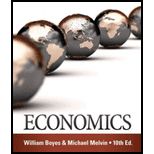
(a)
To rank: the given combinations in the order of preference.
Explanation of Solution
1st preference is "I" as both goods are more.
2nd preference is F and H, as 5 goods in total for each combination.
3rd preference is C, E and G, as 4 goods in each combination.
4th preference is B and D as 3 goods in total for each combination.
5th preference is A as lowest combination of goods is given.
(b)
Combinations which cannot be ranked along with the reason.
Explanation of Solution
2nd preference: F and H, 5 goods are given for each combination.
3rd preference: C, E and G, 4 goods are given for each combination.
4th preference: B and D, 3 goods are given for each combination.
A consumer is indifferent for the respective combinations in each preference as there is no information given about price and utility.
Want to see more full solutions like this?
Chapter 21A Solutions
Economics:
- A consumer has a choice of spending $20,000 on a Honda or $14,000 on a Kia. She was observed buying a Kia during the weekend. Does this mean the consumer prefers the Kia to the Honda? Explain your answerarrow_forwardAnswer the given question with a proper explanation and step-by-step solution. If the price of a hot dog is $2, what is the optimal choice for Stewey? A B C Darrow_forwardOwen saw that the price of peaches had gone down, and so he decided to buy more peaches. Based on this information only, what does Owen's reaction reflectarrow_forward
- Which of the following statements captures the meaning of transitivity of preferences?a. If A is preferred to B, then B is less preferred than A.b. If A is preferred to B, and B is preferred to C, then A is preferred to C.c. If A is preferred to B and B is preferred to C, then the preference for A over B is stronger than the preferencefor B over C.d. If A is preferred to C, then there exists B such that A is preferred to B and C is preferred to A.arrow_forwardTRUE OR FALSE. *If Marvin likes "puto bumbong" more than "bibingka" while Rey likes "bibingka" more than "puto bumbong, the marginal utility from "puto bumbong" will become zero for Rey at fewer units while the marginal utility from "puto bumbong" of Marvin will become zero at higher units of consumption.arrow_forwardThe price of good "a" is $5 and the price of good "b" is $15. If the marginal utility of good "a" is 20 then the marginal utility of good "b" must be ________ to have an optimum combination of goods purchased. 80 20 60 4arrow_forward
- Rick thinks either Morty or Summer broke his TV. Morty and Summer each have to decide simultaneously whether to take the blame or blame the other person. If they both blame the same person (both blame Morty or both blame Summer), the person they blame gets a small punishment and utility of -2, while the blameless person gets a utility of 0. Otherwise (if they both blame the other or both blame themselves), they both get a more severe punishment and a utility of -10. Suppose instead there are three suspects: Morty, Summer, and Jerry. Otherwise, the rules are the same as before. Draw the normal (matrix) form of the game. Hint: draw three matrices, with Morty choosing the row, Summer choosing the column, and Jerry choosing between the three matricesarrow_forwardReese thinks peanut butter and chocolate are great when separate, but when they combine they are even more epic. In other words, Reese likes to eat either peanut butter or chocolate, but when he eats them together, he gets additional satisfaction from the combination. His preference over peanut butter (x) and chocolate (y) is represented by the utility function: u(x, y) = xy + x + y Which of the following is NOT true about Reese’s preference? (a) The MRS decreases when x increases.(b) The preferences are homothetic.(c) The marginal utility of y is higher when x = 10 than when x = 5.(d) For any a > 0, Reese prefers the bundle (x =a/2 , y = a/2 ) over either the bundle (x = a, y = 0) or (x = 0, y = a).arrow_forwardHow would I get Marginal utility and Total utility when I only have either or? Answering with the provided table as an example would be appreciated.arrow_forward
- If the price of restaurant meals is overall higher in big cities then you might expect young people in those cities to spend more on those meals as a percent of their income than similar people in the suburbs. The answer must then lie with the preferences of those young people with their utility curves. Do you think that people reveal their preferences in part by where they choose to live?arrow_forwardSolve the utility maximization problem to find H* and Z* please!arrow_forwardWith the aid of a diagram, describe a corner solution and explain the axioms of consumer choice.arrow_forward

 Economics (MindTap Course List)EconomicsISBN:9781337617383Author:Roger A. ArnoldPublisher:Cengage Learning
Economics (MindTap Course List)EconomicsISBN:9781337617383Author:Roger A. ArnoldPublisher:Cengage Learning
 Exploring EconomicsEconomicsISBN:9781544336329Author:Robert L. SextonPublisher:SAGE Publications, Inc
Exploring EconomicsEconomicsISBN:9781544336329Author:Robert L. SextonPublisher:SAGE Publications, Inc



